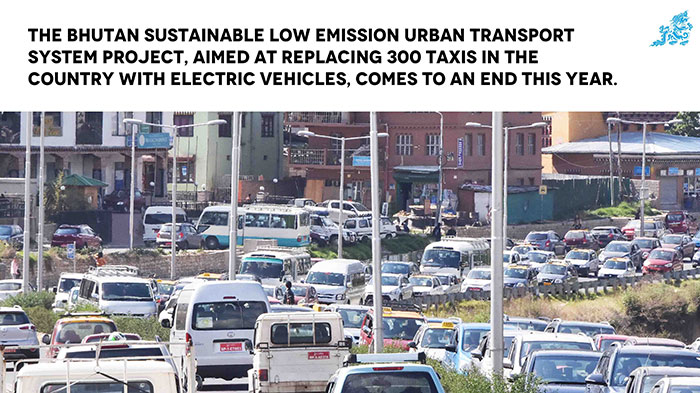Project to replace 300 taxis with EV coming to end without much progress
Yangyel Lhaden
Nearly seven year ago, In 2014, the government introduced an initiative to import electric vehicles (EV) to reduce dependency on fossil fuel and emission of harmful greenhouse gases. To encourage people to go for electric vehicles, tax on import of EVs were exempted.
The initiative could not pick up as expected. The cost of EV and the trust in the new technology was seen as the main reasons. Besides some Indian made EVs, Japan made Nissan Leaf made inroads. However, there were more controversies than the ‘second hand’ (used) cars. Today, there is no record of how many EVs were imported between 2014 and 2017 with the Ministry of Information and Communications ( MoIC).
There are about 128 EV in the country, according to an MoIC official.
Going by the EV trend, it is only the wealthy or the taxi drivers who can afford EVs that selected dealers are importing. Those who can afford it have the benefit of not having to pay import duties while taxi drivers are enticed with subsidies to go electric.
The price of EV cars ranges from Nu 1.5 million (M) to up to Nu 3M depending on the brand. Most private owners, Kuensel talked to said that they bought EV as the second or third car, back-up car in their words.
To revitalise the EV project, a three-year project called the “Bhutan Sustainable Low Emission Urban Transport System,” started in 2019. The projects aimed at replacing 300 fuel driven taxis in the country, with a major focus on the capital city and nearby districts.
The project provides a 20 percent subsidy on the cost of the EV with a maximum ceiling of USD 5,500 (Nu 407,330) and a 70 percent loan facility from the financial institution. A taxi driver has to pay only 10 percent of the cost upfront.
The project comes to end this year, but the speed bumps along the EV road is not cleared. About 200 taxi drivers wanted to buy the EV through the project.
However, because of the pandemic and clearance issues, out of 124 confirmed orders, only nine electric vehicles have reached the country.
An EV dealer, Kuenphen motors, is expecting about 20 EV to reach by the end of next month. The orders were placed in early 2020.
The biggest hurdle on the EV road is the infrastructure. While recognised as a challenge since the beginning of the EV initiative, there are not many charging stations. There are five charging stations that were installed in 2015. Under the Bhutan Sustainable Low Emission Urban Transport System, 25 charging stations in 15 locations in six dzongkhags covering western and eastern Bhutan would be installed by end of May.
Deputy Chief Officer Phub Gyeltshen with Project management Unit under Prime Minister’s Office, said the Covid-19 pandemic disrupted the momentum of the time-bound project. The pandemic is not the only reason. At home, lack of technical expertise hampered the project. It was learnt that the EV project was led by a team of three people who learned on their own about EVs on trial and error method.
With the project ending this year funding from the donor agency will also stop. The government will have to find new sponsors to continue the EV programme. Phub Gyeltshen who has been serving as project manager for since 2019 is also leaving the project and the team has to find another project manager.
“I put all my heart and soul in the project,” he said. It was not enough to move the EV project ahead.
EV not bad, says users
Driving an electric car, those who purchased it, is not bad. A taxi driver, Chencho Wangchuk has been driving an EV- Nissan Leaf since 2016. He bought it for about Nu 800,000 and can drive upto 120 kilometer (km) on full charge.
He recovered the loan within two years. He said that EV was profitable with the electricity bill negligible.
An owner of Hyundai Kona, another EV, said he had to charge the vehicle only twice a month. His EV can drive upto 350 km on full charge. The car’s battery has a capacity of 40 kilowatt per hour (KWh) which translates to 40 units of electricity. Bhutan Power Corporation charges Nu 1.24 for 0-100 units of electricity.
Another owner of Hyundai Kona said he used to drive a Hyundai IIO which gave a mileage of 12km/h and paid around Nu 2,000 to give 350 km. His EV can clock 350 km with Nu 51.2.
EV owners Kuensel talked to said that although EV was expensive, the cost could be recovered in a few years. “Not having to pay for fuel saves a lot,” most EV owners said.
A taxi driver got an EU5, another brand of EV last month. It can drive up to 435 km on full charge. He said when he calculated the profit, it was 75 percent more than a motor vehicle if it had not been for pandemic. His biggest worry is paying back the loan. “The project came at a wrong time otherwise I would have profited from it with fuel price skyrocketing.”
Most taxi drivers said they would not have ordered an EV if they foresaw the pandemic.
Phub Gyeltshen said for a new technology to pick up small incentives mattered. “We are looking into proposing waiving of parking fees and yearly registration fees for EV.”
Meanwhile, Prime Minister Dr Lotay Tshering at the recently concluded mid-term review said that EVs will be used as pool vehicles as one of the initiatives of the government. But the details will be worked out by the Ministry of Finance.
Finance Secretary Nim Dorji said that the ministry will carry out a study and submit recommendations to the Cabinet.


